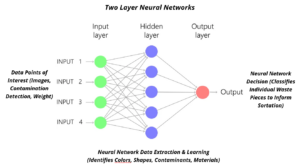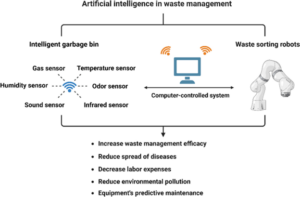What Drives Automation in Waste Management?
Innovation in waste management comes in bursts. Today, the promise of automation through artificial intelligence (AI) offers waste managers a brief window to fundamentally restructure their operations at an unprecedented pace. The primary automation drivers are:
- Regulation
- Rising waste generation
- Labor costs
While these factors are not new, they now coalesce around rising innovation in algorithms and robotics to either increase demand for, or provide much-needed assistance to, automation in waste management.
Regulation is a key driver. California’s SB 1383 requires intensive sortation of organic waste to prevent landfill emissions. Federal oversight is also increasing. In the UK, the Simpler Recycling Initiative is set to improve waste stream purity between recyclable waste and food scraps. The EPA’s e-Manifest Third Final Rule now mandates the digitalization of all hazardous waste tracking, increasing transparency, safety, and providing a plethora of data for innovators to work with. While these pieces of legislation are designed for all business, they pass the responsibility of accurate sortation downstream to large waste managers.
Global annual waste generation is set to reach 3.4 billion tons by 2050, representing a near 150% growth from 2018. As landfills encounter capacity issues today, it is undeniable that solutions encouraging waste valorization and landfill diversion are essential. Automation offers a means to expedite waste management with algorithm-backed systems out-performing manual waste sortation by at least 1,333%. Beyond speed, these systems are more accurate than manual sorters, increasing purity of waste streams by material and ensuring compliance with regulation.
The labor driver is multi-dimensional. Cost savings are dramatic, especially for non-robotic systems relying on compressed air or density screens. Semi-automated facilities can reduce operational costs by 15-35% while full automation can reduce costs by 30-40%. Beyond this though, many novel waste streams like electric vehicle (EV) batteries or chemical waste are far too dangerous for manual sortation and disassembly as evidenced by the recent battery-caused fire in California’s Moss Landing Power Plant. Integrating automation in these facilities will not only save money, but it will also save lives while monetizing some of the most toxic waste on the planet that previously would leach and poison water, soil, and air in landfills.
How data informs smart waste management to achieve socially and economically responsible results is well captured in the figure below.
Source: Artificial intelligence for waste management in smart cities: a review
Who is Working on Automation?
The scale of automation in waste management is enormous and spans over several technology types. While software and sensor solutions can be applied to nearly every aspect of the supply chain, they are perhaps most impactful in material recovery facility (MRF) sortation but also applicable to information collection and transportation. Underlying the robotics and AI revolution in this sector is the great expansion of data through cameras, sensors, and weighing stations. Algorithms can then be applied across a variety of technologies to put this data to work, efficiently.
The key technology offerings are diverse. Optical sorters are high-resolution cameras and sensors paired with computer vision to identify materials based on physical characteristics. Optical sorters are usually paired with robotics, density screens, or air-jet systems to sort waste. AI-powered robotics sort and separate different types of waste materials rapidly and accurately. Air-jet systems use compressed air to eject identified materials into bins, offering exceptional speed with 600-900 picks per minute.
Data analytics platforms like Greyparrot enable this innovation by installing cameras in MRFs and analyzing data to provide insights or software for robotics, ESG compliance, or optical sorters.
Some companies to note here include:
- Greyparrot: Data analytics start-up focusing on using low-cost sensors and cameras paired with innovative algorithms to increase MRF profitability, waste stream purity, and automation.
- AMP: Offers AI-enabled waste management optimization solutions and is moving away from pure robotics systems and towards full facility management/design with a recurring revenue model.
- Waste Robotics: Targeting heavier waste streams such as construction waste using specialized robotic arms informed by layers of sensor data.
- Sadako Technologies: Operating in both robotics and data analytics but aiming to supercharge waste sortation automation at large with computer vision algorithms.
How is Data “Put to Work”?
The figure below provides a very simple version of how these start-ups and larger corporates are implementing AI-informed decision making. A two-layer neural network receives specific data sets including weights, photographs, videos, or spectral data to be processed by the algorithm into clear decisions of where to sort types of plastic, chemical waste, food scraps, or EV batteries, automating entire phases of manual labor including classification and decision making.

Source: Forecasting municipal solid waste generation using artificial intelligence models—a case study in India, 2021 (revised)
In reality, the algorithms used by AMP, Greyparrot, Waste Robotics, and Sadako Technologies are far more complicated than the simple network detailed in this figure. Waste management algorithms would contain hundreds or thousands of hidden layers used to process the raw data into actionable insights. The start-ups mentioned have trained their algorithms on years of data often with a specific Neural Network Decision in mind. In the case of Waste Robotics, it was to inform robotic arm behavior and efficiency. Alternatively, firms like AMP and Greyparrot focus on flexibility, gathering large amounts of data on hundreds of types of materials so they can sort as many waste streams as their bespoke clients wish to target.
What to Watch For
MRFs are set to rapidly automate sorting jobs. Pivoting facilities will increase the need for technical workers able to identify and resolve errors with automated sorting equipment, offsetting some job losses. Regulation protecting manual sortation has not been identified today but expect some level of oversight for hazardous waste like radioactive waste, chemicals, or EV batteries.
Anticipate rapid improvements to the technologies outlined above as these AI systems are self-improving, meaning that the longer they are operational, the more effective they will be. Increased waste sortation promises to improve material circularity and recycling, potentially redefining the poor economics dragging down plastic, battery, and textile recyclers.
Algorithm-informed waste sortation has already entered the commercial mainstream with WM, Republic Services, TOMRA, and ABB all incorporating systems designed around AI. Corporate players have been aggressively pursuing partnerships and investment but stop short of acquisition. Should AMP and Greyparrot remain dominant in their current technological superiority, expect high profile waste managers to acquire these start-ups and several other names.



